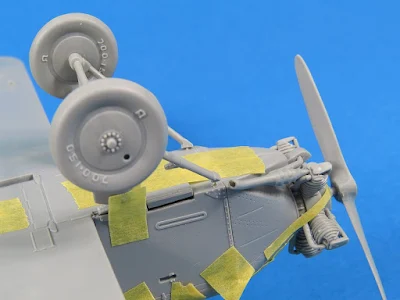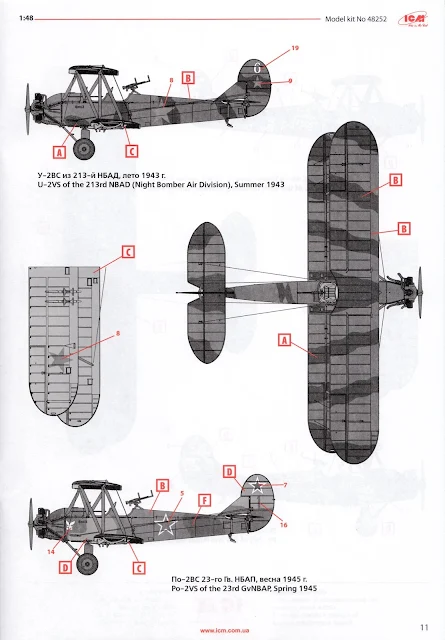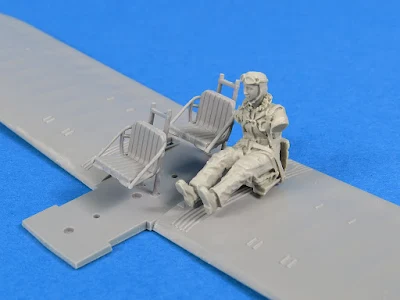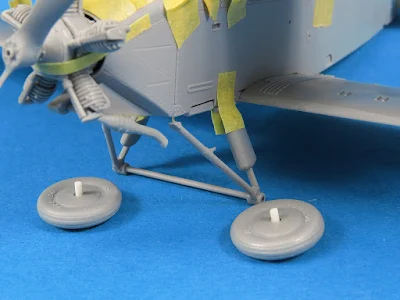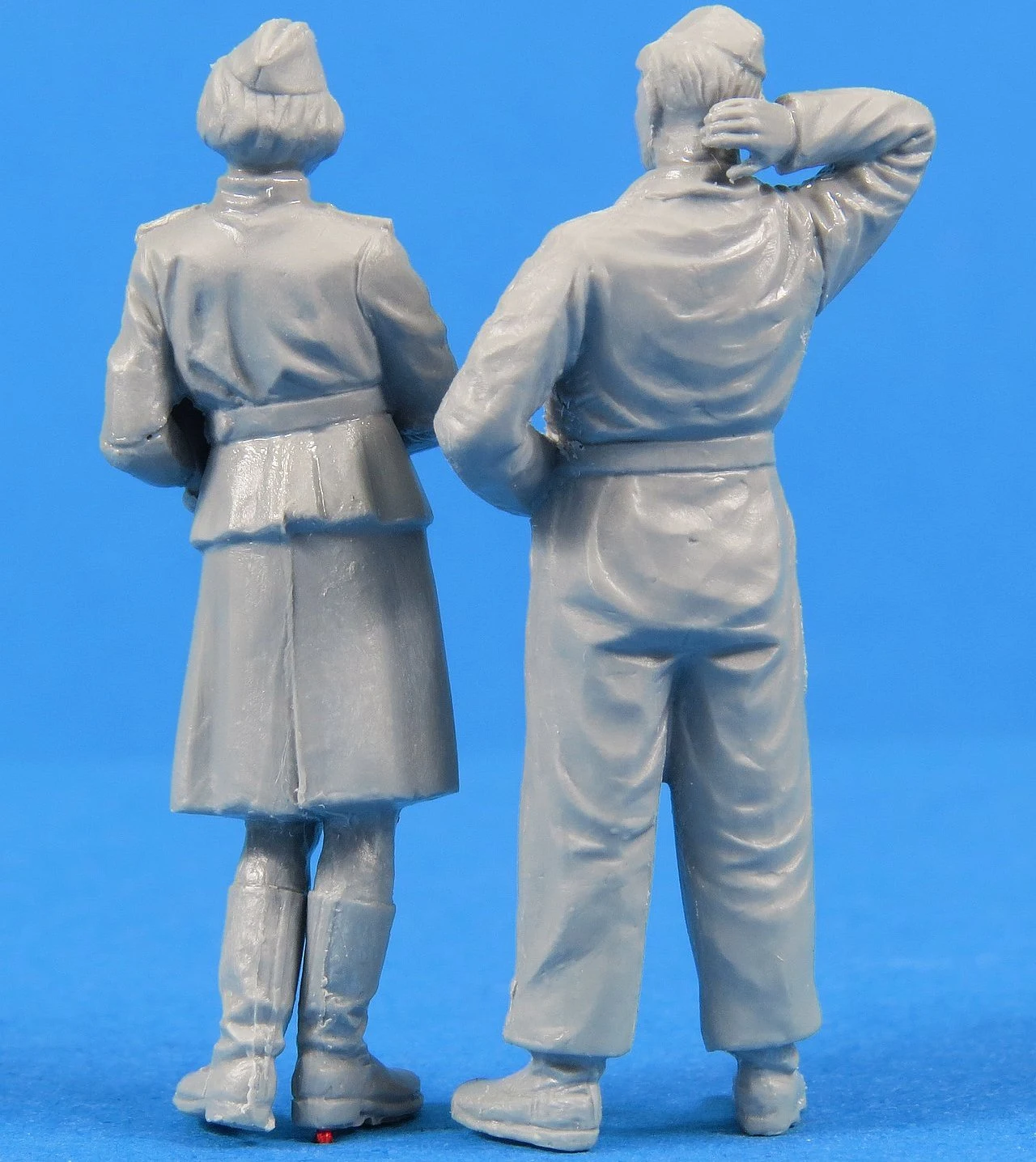Gary Wickham has taken a look at the latest int he family of 48th scale Polikarpov U-2/Po-2VS "Mule" with Soviet Pilots from ICM. It can be easy to think this kit just includes the figures - but the famous "Mule" is packed inside this set also - see what he thought about the kit & the figures in his dry-fit review...
Dry Fit Review: Polikarpov U-2/Po-2VS "Mule" with Soviet Pilots
From: ICM Models
Kit No #48254
1:48th scale
1:48th scale
Product Link on the ICM Website
The Polikarpov Po-2 (also U-2, for its initial uchebnyy ("training") role as a flight instruction aircraft) served as a general-purpose Soviet biplane, nicknamed Kukuruznik ("Crop Duster") with NATO reporting name "Mule". The reliable, uncomplicated concept of the Po-2's design made it an ideal trainer aircraft, as well as doubling as a low-cost ground attack, aerial reconnaissance, psychological warfare and liaison aircraft during the war, proving to be one of the most versatile light combat types to be built in the Soviet Union. As of 1978, it remained in production for a longer period of time than any other Soviet-era aircraft. [source: wikipedia]
The Po-2 became known as the aircraft used by the 588th Night Bomber Regiment, composed of an all-woman pilot and ground crew complement. The unit was notorious for daring low-altitude night raids on German rear-area positions. Veteran pilots Yekaterina Ryabova and Nadezhda Popova on one occasion flew eighteen missions in a single night. The women pilots observed that the enemy suffered a further degree of demoralization simply due to their antagonists being female. As such, the pilots earned the nickname "Night Witches". The unit earned numerous Hero of the Soviet Union citations and dozens of Order of the Red Banner medals; most surviving pilots had flown nearly 1,000 combat missions by the end of the war and took part in the Battle of Berlin.
KIT OVERVIEW - ICM 1:48 Polikarpov U-2/Po-2VS "Mule" with Soviet Pilots (48254)
ICM are quite adept at making the most out of their toolings. Kits are regularly re-issued as new variants and as of late I've noticed they have started to combine two previous kits into a new joint boxing. So it is with this new kit which includes their nice 1:48 U-2/Po-2VS "Mule" biplane together with VVS pilots and ground crew. I have to say first up that I really like the new boxart that ICM are using. Building a model is 9 parts inspiration and their new boxart just draws you into the scene. If you are anything like me, many a kit has been purchased based mainly on the allure of the box top.
The Polikarpov Po-2 (also U-2, for its initial uchebnyy ("training") role as a flight instruction aircraft) served as a general-purpose Soviet biplane, nicknamed Kukuruznik ("Crop Duster") with NATO reporting name "Mule". The reliable, uncomplicated concept of the Po-2's design made it an ideal trainer aircraft, as well as doubling as a low-cost ground attack, aerial reconnaissance, psychological warfare and liaison aircraft during the war, proving to be one of the most versatile light combat types to be built in the Soviet Union. As of 1978, it remained in production for a longer period of time than any other Soviet-era aircraft. [source: wikipedia]
The Po-2 became known as the aircraft used by the 588th Night Bomber Regiment, composed of an all-woman pilot and ground crew complement. The unit was notorious for daring low-altitude night raids on German rear-area positions. Veteran pilots Yekaterina Ryabova and Nadezhda Popova on one occasion flew eighteen missions in a single night. The women pilots observed that the enemy suffered a further degree of demoralization simply due to their antagonists being female. As such, the pilots earned the nickname "Night Witches". The unit earned numerous Hero of the Soviet Union citations and dozens of Order of the Red Banner medals; most surviving pilots had flown nearly 1,000 combat missions by the end of the war and took part in the Battle of Berlin.
KIT OVERVIEW - ICM 1:48 Polikarpov U-2/Po-2VS "Mule" with Soviet Pilots (48254)
ICM are quite adept at making the most out of their toolings. Kits are regularly re-issued as new variants and as of late I've noticed they have started to combine two previous kits into a new joint boxing. So it is with this new kit which includes their nice 1:48 U-2/Po-2VS "Mule" biplane together with VVS pilots and ground crew. I have to say first up that I really like the new boxart that ICM are using. Building a model is 9 parts inspiration and their new boxart just draws you into the scene. If you are anything like me, many a kit has been purchased based mainly on the allure of the box top.
The two "base" kits included here are their original U-2/Po-2 (dating from 2015) and their Soviet Air Force Pilots and Ground Personnel #48084 (dating from around 2007). The sprues did show a little bit of flash but nothing too drastic.
As you can see from the trusty scalemates.com timeline the 1:48 U2-2/Po-2 has been re-issued now four times, in various markings and configurations. Likewise, the figures have been re-popped several times over the years.
ICM provides a total of four sets of marking options in this new boxing, three Soviet and one Polish. I am pleased to see at least one set was for the famous "Night Witches" which was the World War II German nickname for the all-female military aviators of the 588th Night Bomber Regiment, known later as the 46th "Taman" Guards Night Bomber Aviation Regiment, of the Soviet Air Forces. Disappointingly the painting and marking schemes are only provided in black and white in the instruction sheet. The only place we see the actual colours is on the box side (and box top). Other manufacturers do this as well (Kinetic) but then provide a colour PDF version for download on their website.
The decals are minimalistic as is befitting the subject matter. As you can see from the scan they are in register and in the past, I've used ICM's decals with no problem. I also appreciate the inclusion of instrument dial face decals as these work very well with the raised bezels on the kit plastic parts.
The aftermarket manufacturers have also been busy with a variety of sets available that have designed for the ICM Po-2 1:48 family of kits. Here are just a few:
DRY BUILD - ICM 1:48 Polikarpov U-2/Po-2VS "Mule" with Soviet Pilots (48254)
Much like the real aircraft, this model is pretty simple. I don't mean basic, lacking detail, just a fairly low parts count because the original Po-2 itself was a no-frills machine. If you'd like to add a little more detail then Eduard has released a couple of photo-etch detail sets for this kit (FE1004 & FE1005) which include pre-painted instruments, seatbelts and a lot of small improvements on and around the general airframe, mostly related to the rigging and wiring.
DRY BUILD - ICM 1:48 Polikarpov U-2/Po-2VS "Mule" with Soviet Pilots (48254)
Much like the real aircraft, this model is pretty simple. I don't mean basic, lacking detail, just a fairly low parts count because the original Po-2 itself was a no-frills machine. If you'd like to add a little more detail then Eduard has released a couple of photo-etch detail sets for this kit (FE1004 & FE1005) which include pre-painted instruments, seatbelts and a lot of small improvements on and around the general airframe, mostly related to the rigging and wiring.
The level of detail provided by ICM is more than adequate for this scale, especially when you look at the original aircraft and realise how simple it was. Luckily there appear to be many museums and flying examples of the Po-2 still around and so walkaround photos are not that hard to find.
If you would like to display your model with a crew then Aerobonus (by Aires) have you covered with both a:
Soviet Woman Pilot WWII with seat for Po-2 (480154)
Soviet Woman Gunner WWII with seat for Po-2 (480155)
Both figures are well moulded and come complete with the seat, belts and adjustable arms. These pair will be perfect for a Night Witches aircraft (which is what I'm guessing AeroBonus had in mind). Once you have decided which way you want the cockpit, the joined fuselage simply slides over the top and can be glued into place.
Here we see the whole fuselage, lower wing and cockpit assembly together. The fit is very good and with appropriate painting will look convincing I'm sure.
Good detail photos of replica or museum Po-2's are fairly abundant on the net. A close study of wartime photos mainly shows the tiny pushrods and rocker arms for each cylinder exposed. ICM have tried their best to mould the two pushrods for each cylinder but it will be much better to replace the plastic parts with thin brass or plastic rod I believe. Likewise, the two rocker arms on top of each cylinder are not provided in plastic so you may want to scratch build these or just leave them as-is.
The tail is up next and will require a steady hand to correctly attach and secure the "floating" horizontal tails part. What I mean by floating is that it was kind of suspended with a couple of attachment points from what I can see.
Not being an experienced biplane builder I was a bit hesitant at first with the fragile struts but once I had a few secured in place it was surprising how rigid the whole structure became. Tamiya tape was more than able to hold everything in place for this part of the review. To do a biplane justice you will need to eventually tackle the external cabling and rigging. ICM provides a fairly clear diagram of where the rigging is needed on the wings and undercarriage. External control cables also run along the side of the fuselage to the elevators and rudder.
To my eye, the final dry-fitted ICM Po-2 in 1:48 looks pretty spot on. As you can imagine its only a small model when completed, even in 1:48. Thinking about it this would be an ideal candidate for 1:32, something for ICM to think about perhaps. It's also worth mentioning that the kit does come with underwing racks and bombs as the Po-2VS was adapted to carry 50 or 100 kg (110 or 220 lbs) bombs up to a total weight of 350 kg (771 lb) and armed with ShKAS or DA machine guns in the observer's cockpit.
This boxing also includes the single sprue kit Soviet Pilots and Ground Personnel kit (48084). On the one sprue, we are provided with no less than seven (7!) 1:48th scale figures. Like most of the ICM figures sets I have assembled, these figures all went together without a problem. I like figures which have dynamic poses in addition to those which are simply standing around and these seven figures provide a good variety.
FINAL THOUGHTS - ICM 1:48 Polikarpov U-2/Po-2VS "Mule" with Soviet Pilots (48254)
Before this kit arrived on my desk I had never really heard of the Polikarpov Po-2, nor had I any idea of how the Night Witch female pilots used this aircraft in the war against the German infantry.
However, it did not take me long to begin to understand the significance of this understated workhorse which was one of the most produced aircraft, and may be the most produced biplane in history, with as many as 30,000 Po-2s built between 1928 and 1959.
This is a simple kit, of a simple aircraft, done to a fine standard by ICM. If built well (with some of the available aftermarket upgrades), combined with the included figures and a nice base I think this kit would turn into a compelling model.
I'm happy to warmly recommend this kit and when you consider the inclusions believe it's good value for money.
Gary Wickham
ICM provides the interior sidewall ribbing detail directly moulded onto the fuselage interior as shown here. I was curious at to what the cone-shaped fittings were and after a quick search found them to be the inter-cockpit communications system, no push to talk systems here !! There are a few ejection pin marks visible on the sidewalls but I suspect they will mostly be hidden once the interior is assembled and installed.
The fuselage nose is provided as usual in two halves (B1 & B2). I have learnt that rather than join the two halves together and then marry them to the main fuselage I get a better result (no step) if I instead attach the nose halves to their corresponding main fuselage half first. This allows the use of liquid glue from the inside of the join, which has a much lower chance of making a mess.
The seats are assembled and attached to the cockpit floor, which in this case is also part of the lower wing assembly. Likewise the rudder pedals and control columns. From reference photos, the provided seats look to be accurate and only some belts would be needed to finish them off.
Soviet Woman Pilot WWII with seat for Po-2 (480154)
Soviet Woman Gunner WWII with seat for Po-2 (480155)
Both figures are well moulded and come complete with the seat, belts and adjustable arms. These pair will be perfect for a Night Witches aircraft (which is what I'm guessing AeroBonus had in mind). Once you have decided which way you want the cockpit, the joined fuselage simply slides over the top and can be glued into place.
A useful photo of a museum Po-2 shows just how simple that cockpit interior is. It also gives an idea of the interior colours, although I'll leave it to the VVS experts to determine if that shade is accurate or applied post-war.
Probably the most complex part of the build (if you can call it complex) would be the engine. The Po-2 was powered by the 86 kW (115 hp) M-11K radial piston engine. No cowling was used and the engine sat fully external to the fuselage. This makes the engine and exhausts a very visible centrepiece for the model and taking some extra time and effort on the engine will be worth it.
Overall, I feel the engine parts are not a bad effort from ICM. The cylinder cooling fins are adequately done (pretty much to the limit of injection plastic moulding I would think) and the delicate exhaust stubs are also nicely done. In my searching, I could not find any photos which showed part A5 (a cover) fitted during wartime (or even post-war), so I plan to just leave that off, which will have the added benefit of making more of the engine crankcase and cylinder detail visible.
The completed engine is simply attached directly to the fuselage nose. To fit the exhaust stubs, I lightly drilled out the existing attachment holes in the cylinders to provide a firmer fit. I'm not sure if its best to attach the exhausts before or after mounting to the fuselage, more testing needed I guess.The tail is up next and will require a steady hand to correctly attach and secure the "floating" horizontal tails part. What I mean by floating is that it was kind of suspended with a couple of attachment points from what I can see.
The fit and alignment needs a bit of attention before you apply glue here. In the previously mentioned Eduard PE set you to get replacement parts for A2 and the mounting points for the control cables on the rudder and elevators.
The fixed main undercarriage consists of only three parts (not including the wheels themselves) but make sure you pay careful attention to the alignment of the main struts (C21/C30) to the fuselage when you glue part A9 in place. It is very easy for the whole assembly to sit at the wrong angle so I taped the top of the struts to the fuselage as the glue dried.
I was also not satisfied with the flimsy mounting point for the main wheels to the axle and I drilled out the ends and fabricated a newer (longer) one from round stock. This provided a much better result with a far more solid feel to the finished assembly. If you look closely you may also note that I used a brass rod to reinforce the points where the strut supports attach to the lower fuselage as this was also a very uncertain and flimsy connection. The last thing you can see is that I have drilled out the ends of the exhaust stubs.
Being a biplane means of course at some point you need to deal with mounting that second wing. The support struts are first attached to the upper wing ( that seemed to be the easiest option) and then the whole assembly is gingerly positioned onto the lower wing.Not being an experienced biplane builder I was a bit hesitant at first with the fragile struts but once I had a few secured in place it was surprising how rigid the whole structure became. Tamiya tape was more than able to hold everything in place for this part of the review. To do a biplane justice you will need to eventually tackle the external cabling and rigging. ICM provides a fairly clear diagram of where the rigging is needed on the wings and undercarriage. External control cables also run along the side of the fuselage to the elevators and rudder.
To my eye, the final dry-fitted ICM Po-2 in 1:48 looks pretty spot on. As you can imagine its only a small model when completed, even in 1:48. Thinking about it this would be an ideal candidate for 1:32, something for ICM to think about perhaps. It's also worth mentioning that the kit does come with underwing racks and bombs as the Po-2VS was adapted to carry 50 or 100 kg (110 or 220 lbs) bombs up to a total weight of 350 kg (771 lb) and armed with ShKAS or DA machine guns in the observer's cockpit.
This boxing also includes the single sprue kit Soviet Pilots and Ground Personnel kit (48084). On the one sprue, we are provided with no less than seven (7!) 1:48th scale figures. Like most of the ICM figures sets I have assembled, these figures all went together without a problem. I like figures which have dynamic poses in addition to those which are simply standing around and these seven figures provide a good variety.
FINAL THOUGHTS - ICM 1:48 Polikarpov U-2/Po-2VS "Mule" with Soviet Pilots (48254)
Before this kit arrived on my desk I had never really heard of the Polikarpov Po-2, nor had I any idea of how the Night Witch female pilots used this aircraft in the war against the German infantry.
However, it did not take me long to begin to understand the significance of this understated workhorse which was one of the most produced aircraft, and may be the most produced biplane in history, with as many as 30,000 Po-2s built between 1928 and 1959.
This is a simple kit, of a simple aircraft, done to a fine standard by ICM. If built well (with some of the available aftermarket upgrades), combined with the included figures and a nice base I think this kit would turn into a compelling model.
I'm happy to warmly recommend this kit and when you consider the inclusions believe it's good value for money.
Gary Wickham
Thanks to ICM for sending this kit to Gary to put together in his review - it is now available from ICM's Distributors Worldwide
Instructions of the kit...

